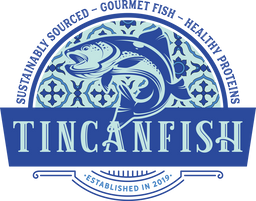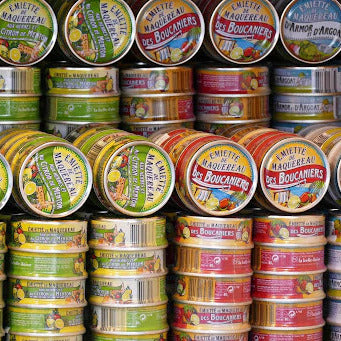Note: fact-checking and scientific research were used in the creation of this article, but the views expressed are opinions and not based on original research by TinCanFish.
Delicious, salty seafood scooped out from a tin has been a beloved snack and defining trait of cultural cuisine for generations. Anchovies, sardines, squid - packaged in a tin, these delicacies have traveled the world through time and nostalgic memories.
However, few people know the origin story behind this global phenomenon - and the waves of history that have defined this table staple are fascinating, bobbing through defining events of creation, innovation, crisis, and opportunity.
Today, we’ll swim through the simultaneously ancient and modern tale - a tinned fish creation myth of sorts. It’s the perfect narrative backdrop and a saga that is sure to make your next gathering of family and friends and tinned fish all the more interconnected and meaningful.
In the Beginning
According to scientists’ best guesses and theories, Homo sapiens have been experimenting with agriculture for about 10,000 years. Before that, our family groups and lives revolved around hunting and gathering food in order to survive.
One evidence-supported theory revolves around our ancestor, Homo erectus. Archeologists, through scientific studies, hypothesize that this bi-pedal predecessor consumed high-calorie meat and bone marrow in addition to the plant-based diet that defines other primate species eating patterns.
The first example we have of humans eating fish is an ancient origin story indeed: about 1.95 million years ago, somewhere on a shoreline in a landscape currently known as Kenya, a group of our ancestors gathered and deboned a catfish, harvested a turtle, and defleshed the foot of a crocodile. While this meal is a far cry from a Wisconsin fish fry or a bustling sushi bar at a subway station, it is part of a profound lineage of people gathering together to dine upon the treasures of sustenance that swim in the water. Take the arctic regions for instance: Inuit hunter-gatherers and other indigenous groups historically (and in instances today) get 99% of their caloric intake from seals, narwhales, and fish.
We see this echoed again and again in different areas of our vast planet, in books, and in oral history: human survival incorporating the enthusiastic and ongoing consumption of fish.
Tin and Fish
And with fish as a prevalent food staple, it’s no surprise that humans set their big brains to figure out how to save and store fish for extended periods - further stabilizing sources of sustenance for growing communities. Fermentation of fish is an old practice with many variations depending on the culture.
Here’s where tinned fish comes into the picture:
In 1795, a Frenchman named Nicolas Appert began experimenting with preserving fish in jars. The French government, in the throes of the Napoleonic wars, was awarding prize money to anyone able to preserve food in a cheap and effective manner. Appert submitted his canning technique and invention, and, subsequently, he won this prize in 1810. However, Appart used glass jars - which presented problems for transport due to their fragile nature.
British inventor Peter Durand solved this problem and patented his own fish preservation method: fish in a tin can. Thus, we arrive at our modern-day process. Another Englishman, Joseph-Pierre Colin, further adapted the technique with sardines, specifically, and kicked off large-scale production of these products at a canning factory in Nantes, France.

War Time Necessity Becomes A Beloved Portuguese Delicacy
In the events of the two great world wars, communities and economies resorted to desperate means of survival. These choices had immense impacts on the world today.
Examples of this are innumerable in art, literature, music, governmental systems, and subsequent regimes. There are horror stories, and then there are the smaller, lighter consequences we have to pay attention to in order to notice.
For example, Portugal, during the great wars, massively expanded their tinned fish production in order to support the war effort. Portugal helped supply Europe (as well as troops on other continents) with easy-to-transport, nutritious, and long-lasting cans of sardines.
As a result, tinned fish became a specialty in Portugal, a reputation that still stands to this day. The terrible scenarios of war transitioned to the daily habits of many Portuguese families - the traditions of which have transferred from generation to generation.
Now, tourists partake in tinned-fish-themed experiences while visiting the Iberian peninsula, and often take home tins as souvenirs and mementos (good thing they’re so easy to transport!).

A Global Marketplace
Portugal isn’t the only place to buy tinned fish today - it never really was despite its reputation.
Across the globe, tinned fish remains an effective, cost-efficient, shelf-stable way to feed large amounts of people. From Indonesia to Japan, from Sweden to the coast of Alaska, there is a large demand for this product.
In the context of the 2020-2021 pandemic, demand from consumers continued to boost. Sales in Alaska, for example, reached record heights.

The Future Of Tinned Fish
But of course, tinned fish is more than just a product. As with any organism on planet earth, fish (before they are harvested and tinned) are an important aspect of food chains, ecosystems, and environmental health.
And the growing demand for tinned fish does not happen within a vacuum. Our economies are deeply intertwined and our societies continue to develop in predictable and unpredictable ways. By 2050, we’ll need to figure out how to feed an additional 2 billion people. Obviously, various diets will have a massive impact on the way our world looks - especially since big agriculture contributes alarming amounts of greenhouse gases into the atmosphere and uses appalling amounts of precious water. And with continued development around the world, the consumption of meat and dairy is on the rise, too.
When it comes to the origins of tinned fish, we can follow the currents of history with some degree of clarity. But how does the story unfold from here? What is the future of tinned fish? And how does it reflect our own trajectory as a species on this precious planet?
These are complicated questions - and the solutions are numerous. With the inventive technologies of those who came before us and an ethic of sustainability and activism in current generations, tinned fish will absolutely be part of a more balanced future.
You are what you eat. And often, you are what your ancestors eat. The future of this story depends on the choices we make today, the organizing we do in honor of the delicate planetary systems we impact, and the creative approaches we use to sustainably consume what we need to survive.


